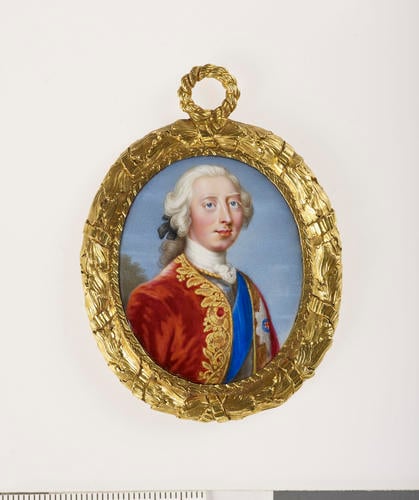-
1 of 253523 objects
Frederick, Prince of Wales (1707-1751) c.1743-1751
Enamel | 4.3 x 3.6 cm (sight) (sight) | RCIN 421809
-
Frederick Lewis was born in Hanover, the first child of George Augustus, electoral prince of Hanover, later George II, King of Great Britain and Ireland (1683–1760). When his grandfather was proclaimed king in 1714 most of the family moved to England but Frederick, aged seven, was left behind in Hanover as a representative of the electoral family. By the time he was required to rejoin his family in England in 1728, he was already on bad terms with his father and in debt to the sum of over £100,000. In England, Frederick re-built the White House at Kew, developed an interest in art, and commissioned a barge, more stylish and faster than any of the king’s barges and now in the National Maritime Museum. In 1736 he married Princess Augusta of Saxe-Gotha (1719–1772) with whom he had had seven children. The prince’s relationship with his parents continued to deteriorate and developed into a national scandal. Frederick’s demands for money and his father’s refusal to give it to him resulted in Frederick appealing to parliament against the king. Frederick ran his own rival court and his political manoeuvring against Sir Robert Walpole, his father’s chief minister, caused bitterness and division. Frederick pursued his interest in the arts and commissioned George Vertue to make lists of the royal art collections as well as making copies of the inventories of the collections of Charles I and their sale by the Commonwealth. He died in 1751 and was buried in Westminster Abbey, without any members of the royal family present. There are several versions and variants of this portrait in the Royal Collection, none actually signed and dated by the enamellist Christian Frederick Zincke, but nonetheless all by his hand. (Royal Collection, RCINs 421831, 421829, 421423, 3754). Here the Prince of Wales wears a uniform coat with gold oak leaf facings over a gilt-edged steel cuirass (a piece of body armour), and the ribbon and star of the Order of the Garter. The oak leaves were a symbol of victory in the battlefield for the Hanoverians, and relate to the triumphant return of Frederick’s father, King George II and Frederick’s younger brother, the Duke of Cumberland, after the battle of Dettingen in 1743. Frederick had never been allowed to take command of the army, but he held the rank of General Officer and would have worn the oak leaves to celebrate the occasion. Christian Frederick Zincke was born in Dresden, the son of a goldsmith. He settled in England in 1706 and studied enamel painting under Charles Boit. He developed a thriving business, at first copying portraits by Sir Peter Lely and Sir Godfrey Kneller, then painting from life. He worked extensively for the royal family and, perhaps because he spoke German, was one of the few artists George II could tolerate. By 1730 he was well established at court and in February 1732, was appointed Cabinet Painter to Frederick, Prince of Wales. His eyesight began to fail, however, and he lamented: ‘I find my Eyes scarce Capable of seeing them fine strokes’. By 1752 he had retired and only painted for his own pleasure. George II commented that Zincke’s portraits were ‘beautiful and like’.
Provenance
Probably acquired by Frederick, Prince of Wales; first certainly recorded in 1858
-
Medium and techniques
Enamel
Measurements
4.3 x 3.6 cm (sight) (sight)
5.7 x 5.0 cm (frame, external)
